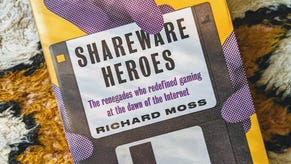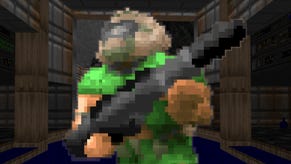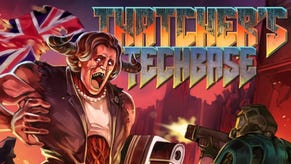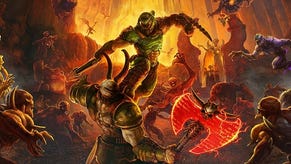Doom retrospective
From the archive: 20 years of the game that didn't just change gaming forever - it changed gamers.
To mark the anniversary of Doom's release, 20 years ago today, here's a treat from the Eurogamer archive: Paul Dean's retrospective essay on the game, first published on 15th January 2012.
Holy s***, there's a monster in the lift.
That's not supposed to happen. The lift is the end of the level. It's a safe zone, a chance for a breather before the game totals your score. For God's sake, it's a universally acknowledged cessation of hostilities. But this time, there's a monster in the lift and both my friend and I physically reel with shock, spasming backwards as the thing lurches towards us. Later, at school, we'll laugh with our classmates at all the stories of involuntary noises and slapstick jerking that this new game produces. Then we'll go home and make it happen again.
I suppose it means that we're suckers for punishment, but we're giving as good as we get and our screens are frequently full of pixelated gore, our ears ringing to the sound of screams and explosions. Yeah, that's just how our evenings go.
The two of us are 13 and we've both been playing video games in some form or another since we were toddlers. Doom is not only the best looking thing we've ever seen, but it's also the first game that's ever given us any sense of fear, that's ever reached right down to our brainstem and tugged hard.
The fingerprints (or perhaps the clawmarks) that it left still remain, permanent impressions left in not only our own gaming memories but also across the collective unconscious of modern videogaming. For two young teens in the early 90s, Doom is merely the next big thing in a rapidly-accelerating gaming industry that soon leaves it behind. We never really notice that it's Doom itself which had stamped its boot on that accelerator, but we'll have Doom to thank for so much that we'll come to take for granted, its influence scattered across modern video games like shotgun pellets.
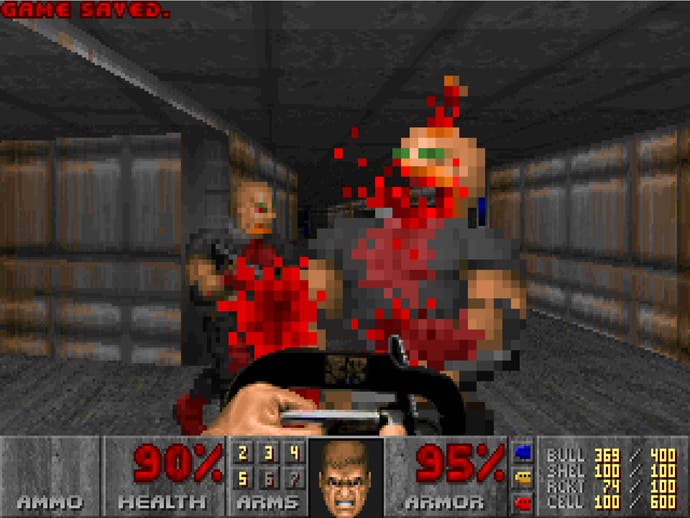
Doom was released in December 1993, and on those long, dark winter evenings we both find moments where we absolutely, positively do not want to progress, where the game makes us so nervous that we refuse to participate. It's a strange experience, feeling nervous about playing a game you so enjoy, but it might be that, just as we're hitting puberty and getting to grips with our emotions, we find our video games are also coming of age. Doom only wants us to get in touch with our emotions too, it just turns out that the most basic of these happens to be fear.
It knows about darkness, it knows about environment, it knows about pacing and it knows about surprise. It likes to cut the lights, to groan from the shadows and, like some wicked labyrinth in a gothic fairytale, even its very structure can't be trusted. Floors fall away into pools of acid, walls suddenly disappear to reveal hordes of hungry hellspawn and, just when you need it, you tentatively reached for a new power-up or weapon only to find yourself enveloped in blackness, listening to the howling of approaching demons. Everything about this game is geared around giving a response to its players, to where two boys go and to what they do.
Doom played with its world as much as it could, demanding that you never trust it, that you always second-guess it
No game had ever been able to use technology to create such an emotional response before. id's previous shooter, Wolfenstein 3D, was a cartoon shooting gallery in comparison. Doom played with its world as much as it could, demanding that you never trust it, that you always second-guess it. While John Carmack, creator of Doom's game engine, might have pooh-poohed the idea of any sort of background or plot for the game, insisting that "Story in a game is like a story in a porn movie," he was nevertheless able to bury his players into an experience more tangible and visceral than anything they'd ever known.
But to an idealistic young boy like me, Doom was far more important for introducing two things to gaming that I'd long, long yearned for, two things that I'd secretly dreamt of but that I wasn't sure anyone would be able to realise. They were also two things that would have an enormous and lasting impact on all of gaming.
The first was frantic, extraordinary and unpredictable: it was other people. Not other people clustered around the same keyboard or taking turns in some tedious hotseat arrangement. It was other people on other PCs, even people in completely different towns or countries. Anyone who had an internet connection, access to networked PCs or enough money to buy a simple null modem cable could unlock a whole new gaming experience.
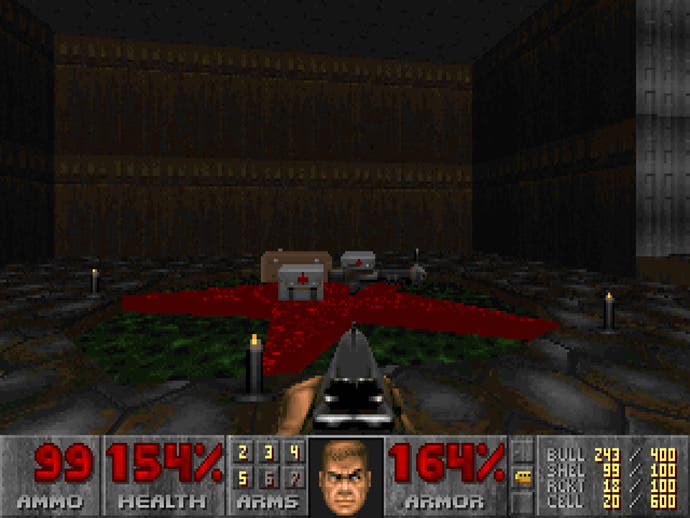
In my head I'd imagined how multiplayer Wolfenstein might work, what it would feel like to be part of a cadre of scarred veterans battling the odds and grasping at our gut wounds, but I'd never pictured this much energy, this much sheer adrenalin as you watched one friend's rocket turn a bad guy into pure goo, while another was torn apart beside you by the talons of a gurgling imp.
Nor had I imagined the alternative to this: deathmatch. We could turn the guns on one another, celebrate senseless murder and use every cruel trick of the environment to our advantage. Wickedness overtook us as we became the monsters lurking in the shadows, or the hand on the lever that dropped some unsuspecting soul down into a sea of radioactive waste. We were more devious and deadly than any of the game's monsters, turning its levels into slaughterhouses and abattoirs. We were bastards and we loved it.
Doom also introduced the concept of modification, encouraging its players to tweak and tinker with its media and its levels. Carmack deliberately programmed the game so that replacing sound and graphics would be both simple and reversible. He also made the code for the game's level editor available to the public.
While the move might have seemed like poor business sense, as if id was giving its secrets away for free, it only encouraged even more people to play and to talk about the game while, of course, fostering a whole generation of modders and level creators. I desperately wanted a Star Wars FPS and, a year before Dark Forces was released, I got it. The early internet was afire with discussion and development as both amateurs and professionals tried their hand at modding, inspired by Doom's own devious designer, John Romero.
And these names themselves - Romero, Carmack - became a currency among my friends, the first game developers that were household names to us. We finally saw game developers being treated like film directors and rock stars, being the heroes we'd always felt they were and even behaving like them. The long-haired, trash-talking Romero enjoyed meeting with his fans as much as they enjoyed meeting him, and when five students in Austin, Texas scraped together to buy a space above a café where people could pay to play multiplayer Doom, he turned up to give them his blessing. A dedicated social space, purely for the playing of computer games? I was jealous that we didn't have one.
"Over the centuries, mankind has tried many ways of combating the forces of evil. Prayer, fasting, good works and so on. Up until Doom, no one seemed to have thought about the double-barrel shotgun."
Terry Pratchett

Developers like Peter Molyneux and Will Wright would become just as fascinating and famous, but it was Doom's designers who were the first to stand out, the first names to become as important as their games. As I turned the pages of the technology and games magazines I collected, I would read of their latest public appearances or, as the years rolled on, their growing estrangement: id software hired and fired more and more staff; the development of their mysterious follow-up, Quake, stalled; Romero eventually left to form Ion Storm.
Among teenage gamers like us, such news spoke of great potential and of great drama. We wanted to know more about the people behind our games, more about who made them and how, and the spats and the self-destruction, the fallouts and the firings gave us all the soap operas and drama that we ever needed, at least as worthy of a dramatisation as Facebook's story was. (And after Carmack and Romero split, neither would develop anything as truly groundbreaking again.)
Doom was also the first time that I ever saw my hobby validated by the wider world. It grew large enough and reached far enough that both the media and the general public began to understand that, young or old, people play games. Doom II was featured in ER. Queen guitarist (and amateur programmer) Brian May expressed his astonishment at the game's technical achievement.
Fantasy maestro Terry Pratchett decided to applaud the game's approach to the problem of evil: "Over the centuries, mankind has tried many ways of combating the forces of evil," he said, "Prayer, fasting, good works and so on. Up until Doom, no one seemed to have thought about the double-barrel shotgun." It even earned a passing reference in Friends (characteristically unfunny, of course).
And then I witnessed controversy unprecedented in both its scope and its ignorance. Even before Doom's release, it was already marked as a game that corrupted young and, despite its popularity waning, it was blamed for inspiring the Columbine Shooting in 1999. After Doom, video games would increasingly find themselves the scapegoats for all social ills, frequently being misrepresented and misreported. Doom II would be the first game that the Entertainment Software Rating Board would classify as "M" for Mature, an implicit acceptance that video games were not just for children, particularly when they involved thrusting a chainsaw into somebody's mouth.
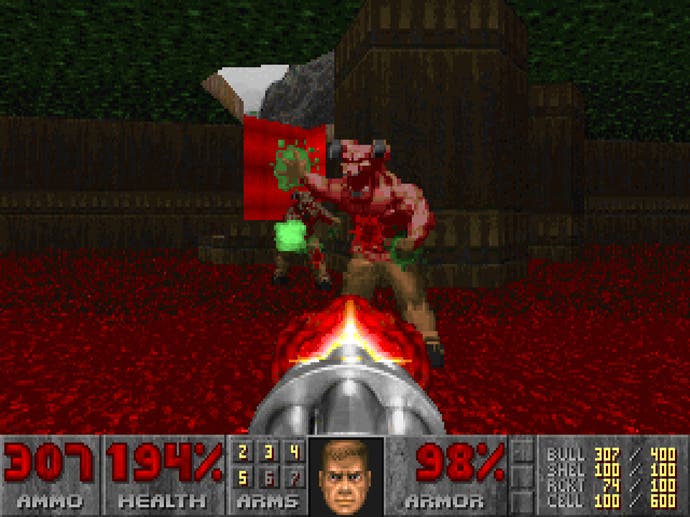
Doom would echo down the years and I saw it reflected again and again in my favourite games, whether I was watching enemies fight one another in Halo; seeing the walls fall away in System Shock; aiming for parts of the environment that would explode in Crusader: No Remorse; watching the shadows in Thief; reloading my shotgun in Counter-Strike. It was the first game I played in a window and the title Bill Gates used to (personally) promote Windows 95's gaming potential.
Both its engine and its ideas had an incalculable influence and more than a few were ahead of their time. It's not always acknowledged that, a decade before Steam existed, Doom's initial distribution happened online.
David Datta, a sympathetic computer administrator at the University of Wisconsin-Parkside, allowed id to upload the shareware version of Doom, its first third, to the university's network. From here, other gamers would be able to log in, download it and further host and distribute it online and offline.
Doom pushed gaming in a dozen different directions at once, some of which mattered to me then, some of which I only appreciate now
id was not interested in a traditional publishing deal, but instead in word of mouth, hoping gamers would pass on shareware copies any way the could, only paying to order the full version. While online distribution may have seemed like a good place to start, id set the trend of developers drastically underestimating their capacity to cope with demand. The University of Wisconsin-Parkside's network collapsed like a house of cards.
When I told my girlfriend that I'd be writing a retrospective on Doom, she asked me if it was scary. I was a little dumbfounded, but she'd been too busy playing on her SNES back then. I tried to explain that Doom was the scary game, but that it wasn't just about fear. Doom pushed gaming in a dozen different directions at once, some of which mattered to me then, some of which I only appreciate now.
There's an old philosophy adage that all western thought is really "a series of footnotes to Plato," so influential was the ancient Greek. When I look back, two decades later, I realise that if my own love of gaming isn't a series of footnotes to Doom, it's at least as peppered by id's shooter as if it had been blasted by a shotgun.
It's no wonder that, 19 years later, it's still being played and talked about in all kinds of places.


